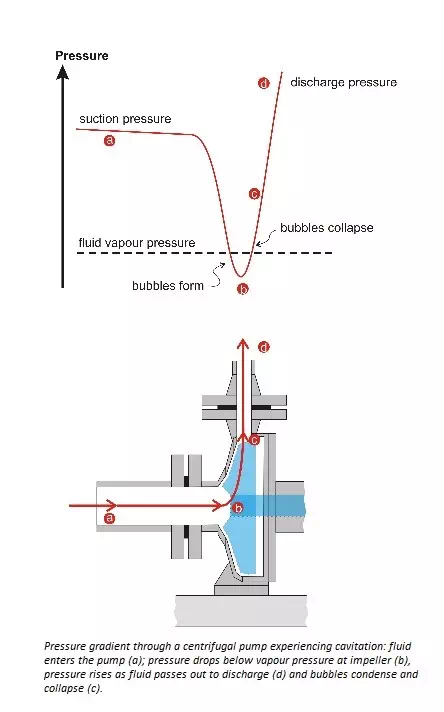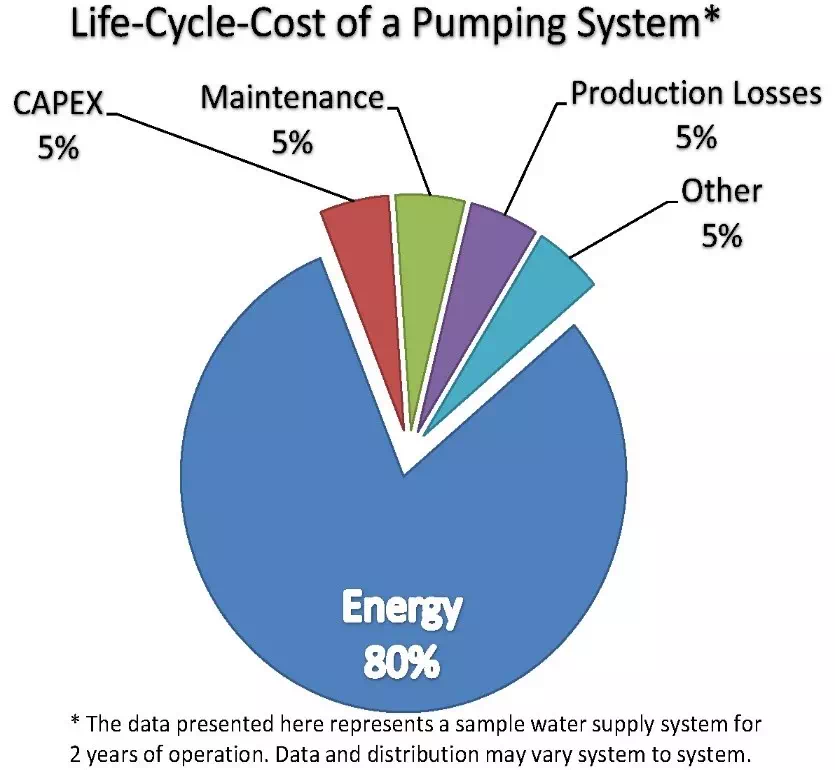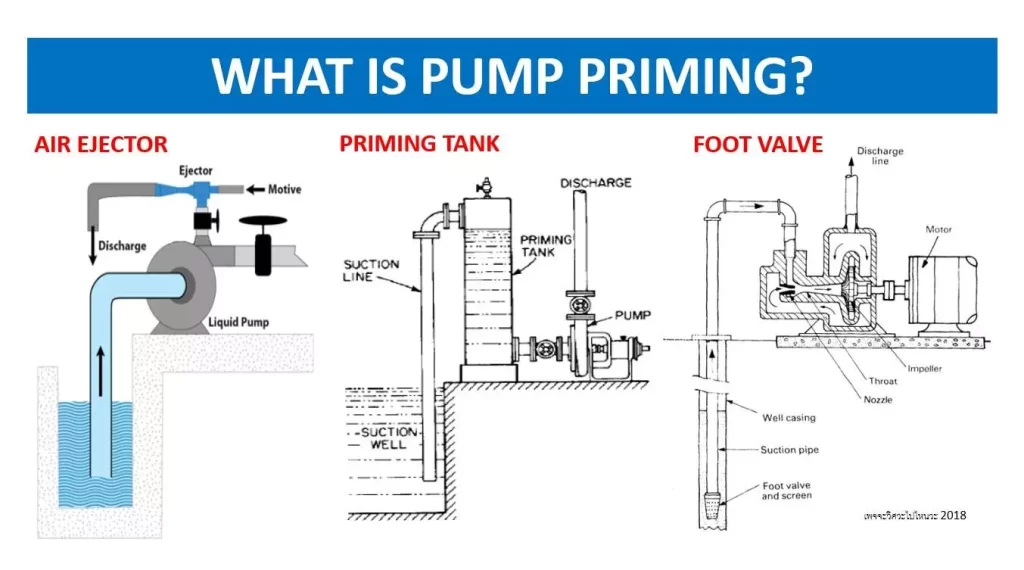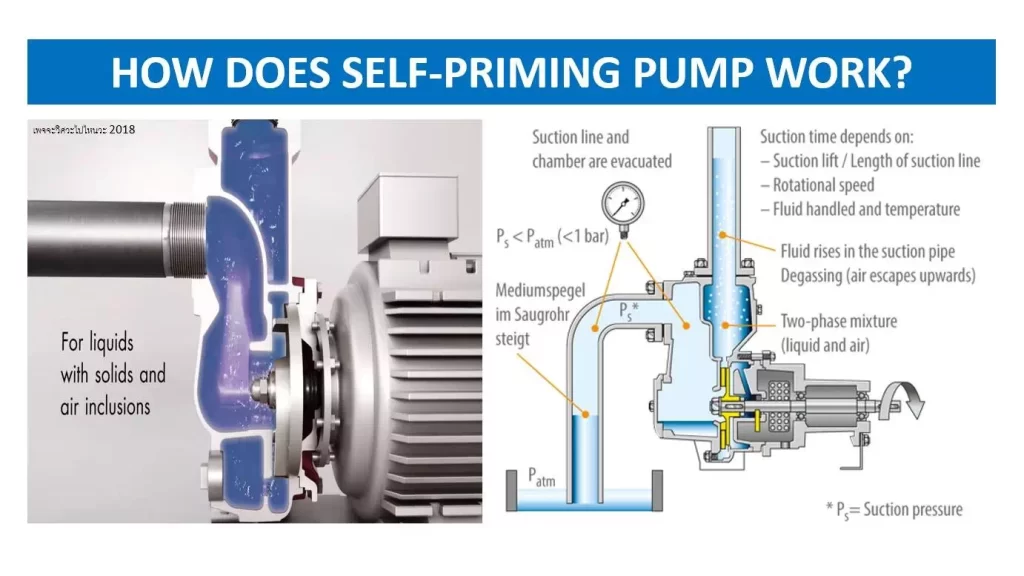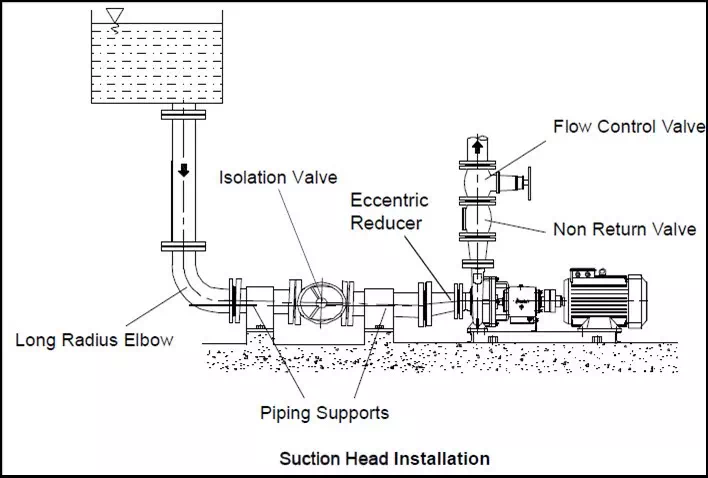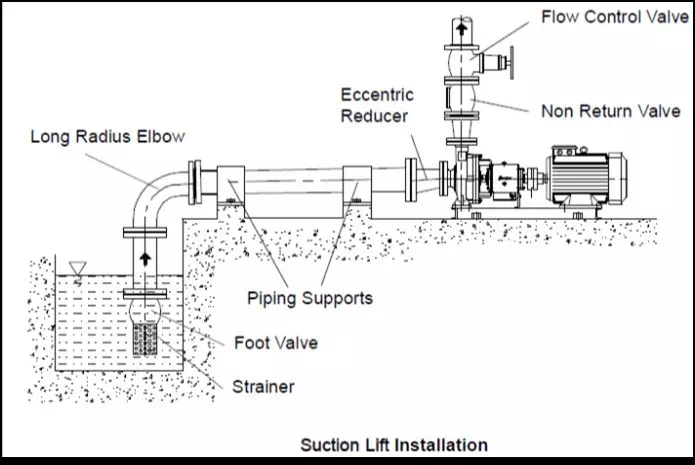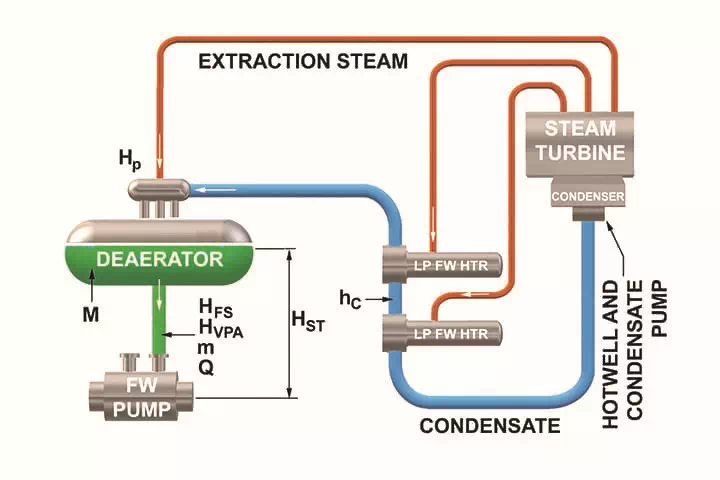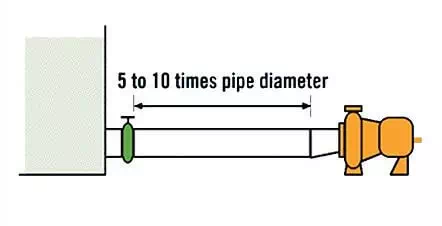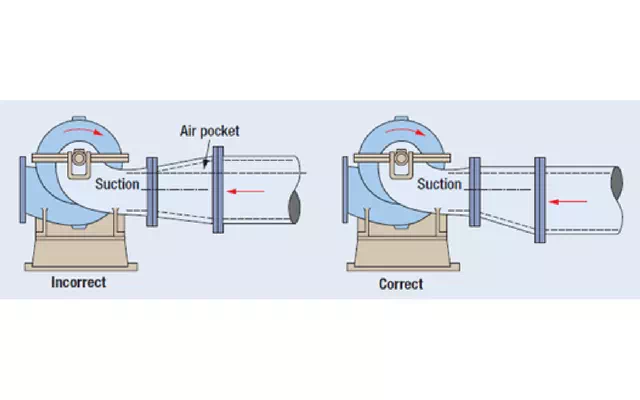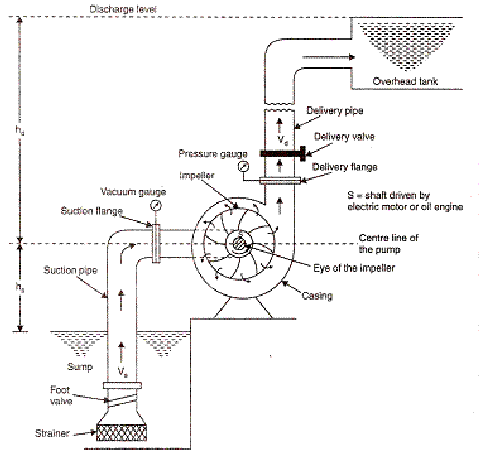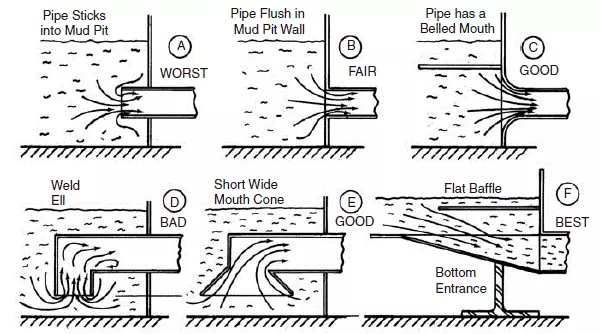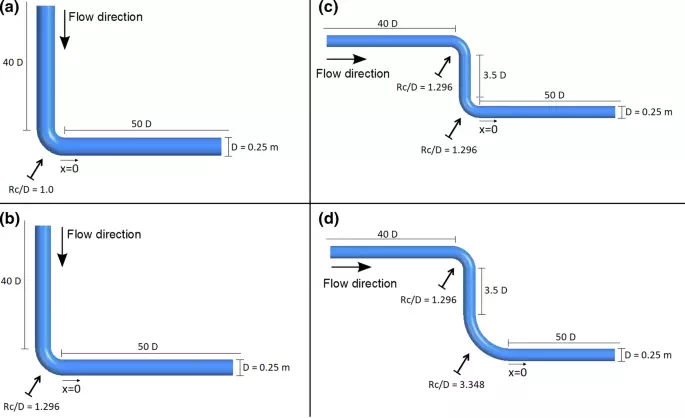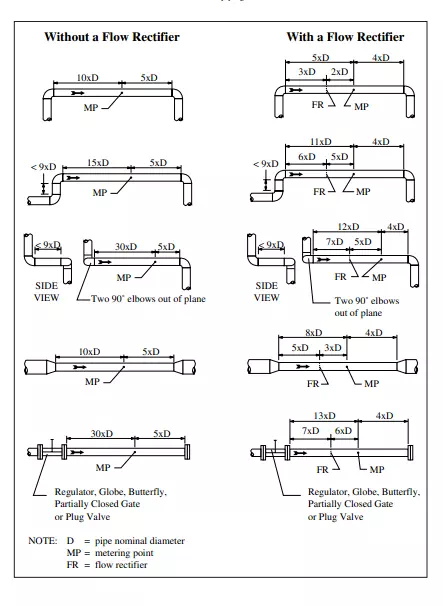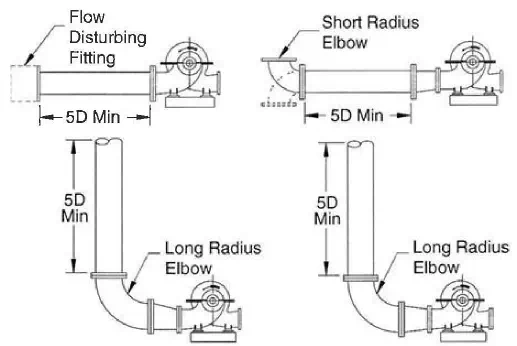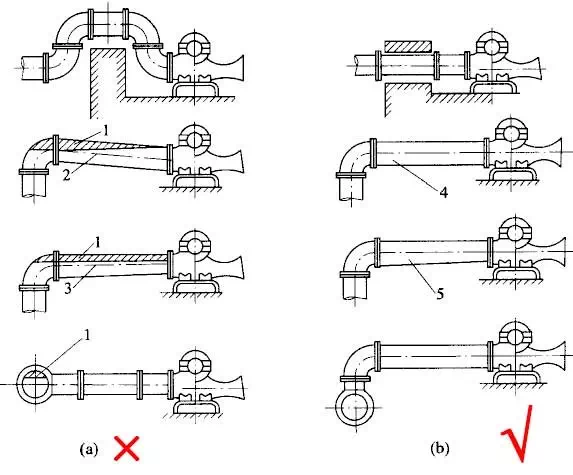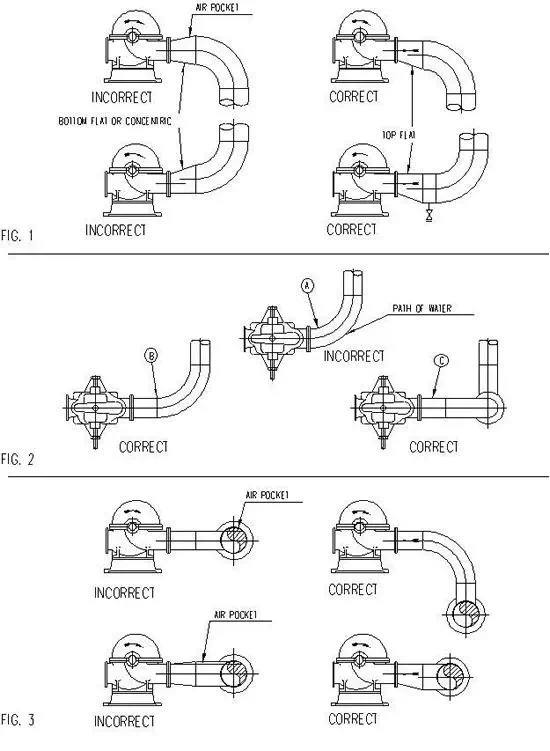การออกและก่อสร้างแบบท่อเข้า (Suction pipe) ของ Centrifugal pump
ปัญหาของระบบท่อขาเข้า (Suction pipe) ของปั๊มแรงเหวี่ยง (Centrifugal pump) ที่พบบ่อยๆ คือ
- ปัญหาการดูดน้ำไม่ขึ้น (Low suction lift) ดูดได้น้อย ปริมาณการใหลไม่สม่ำเสมอ (Flow chattering) ปริมาณการใหลต่ำกว่าขีดความสามารถ (Capacity) ของปั๊ม
- ปัญหาท่อเข้าเล็กเกินไป หรือยาวเกินไป หรือเลี้ยว คดงอมากเกินไป ทำให้เกิดแรงเสียดทานในระบบมาก หรือมีการใหล Turbulent ที่ปากทางเข้าปั๊ม
- ปัญหามีลมในท่อ (Air entrainment) หรือรั่วเข้าไปได้ (Air leakage) ทำให้สร้างสุญญากาศ (Vacuum) ไม่ได้ มีปัญหาในการดูด
- ปัญหาปั๊มมีเสียงดัง (Noise) กว่าปรกติ
- ปัญหากเกิด Cavitation ของปั๊ม เกิดการกัดเซาะ (Erode out) เนื้อวัสดุของใบพัด (Impeller หรือ Rotor) และตัวเสื้อ (Casing)
- ปัญหาของแข็งปน (Solid particles) อยู่มากในท่อเข้า ทำให้ท่อ หรือปั๊มอุดตัน
- ปัญหาระบบรองรับน้ำหนัก (Pipe support) ตัวท่อไม่ดี ติดตั้งไม่เหมาะสม (Improper installation) มีแรงเค้น (Stress) เกิดที่ตัวปั๊ม เกิดการบิดตัว (Distortion) แตกหัก (Crack) ได้
- ปัญหาการขยายตัวหรือหดตัวของระบบท่อ การเยื้องศูนย์ (Misalignment) การบิดตัวของท่อ ทำให้เกิดแรงเค้นที่ปั๊ม ต้องขจัดออกไป หรือต้องให้มีน้อยที่สุด อาจจะพิจารณาการติดตั้ง Expansion joint ช่วย
- ปัญหาการติดตั้งไม่ได้มาตรฐาน (Poor installation skill) ทักษะยังไม่ได้
ซึ่งปัญหาส่วนใหญ่จะเกิดจากไม่เข้าใจคุณลักษณะของตัวปั๊ม (Pump characteristic) และการเลือกขนาดและติดตั้งท่อไม่ถูกต้อง ทำให้เกิดแรงเสียดทานสูงในท่อ การใหลของของใหลไม่สดวก ความดันขาเข้าลดต่ำกว่าความดันไอน้ำ (Vapor pressure) ทำให้เกิดฟองอากาศ (Air bubble) ขึ้นภายในท่อดูด ให้เกิด Cavitation ที่บริเวณท่อดูด และตัวปั๊ม (ดูบทความเรื่อง Cavitation) เกิด Cavitation ที่บริเวณท่อดูด และตัวปั๊ม (ดูบทความเรื่อง Cavitation)
Pump priming
Centrifugal pump จะต้องมีน้ำเติมเต็มท่อดูดอยู่เสมอ (Pump priming) ไม่ยอมให้มีช่องว่างของอากาศในท่อ มิฉนั้นปั๊มจะสร้างสุญญากาศ เป็นแรงดูดไม่ได้ จะดูดน้ำไม่ขึ้น
การออกแบบระบบท่อเข้า จะต้องทำโดยผู้มีความรู้ มีประสบการณ์โดยตรง เพราะหากทำโดยไม่มีความรู้ หากเกิดความผิดพลาดจะเสียเวลาและเงินทองในการแก้ไขมาก
การออกแบบและติดตั้งระบบท่อเข้า มีหลักการในการพิจารณาดังนี้
- Ensure that conditions do not favor cavitation, particularly if you are using a centrifugal pump. This requires careful selection of the pump, its positioning and the head pressure.
- Position the feed pipe to minimize entrainment of air/vapor and solids.
- Minimize friction and turbulence by choosing appropriate pipes and components:
- Use pipes with a diameter twice that of the pump’s suction side flange.
- Ensure that the pipework is aligned with the pump’s flange and straight for at least 5 pipe diameters.
- Use an eccentric reducer orientated to eliminate air pockets.
- Keep the pipe velocity below 2m/s.
Suction Piping: Velocity may vary 1 m/s to 2 m/s, flow changes and NPSHr values shall be considered in detail.
Discharge Piping: Velocity may vary 1,5 m/s to 3 m/s, Life-Cycle-Cost and Water Hammer Analysis needed
Good piping layouts prevent cavitation by helping to maintain constant velocity.
Obstructions in piping layouts affect flow velocity, which changes fluid pressure, which can cause cavitation.
- Ten diameters of pipe between the pump suction and the first elbow.
- The upstream conditions should have a minimum straight run of ten pipe diameters to provide uniform flow to the suction inlet.
- Keep reducers as close to the pump as straight-run requirements allow. Use eccentric reducers, flat side up, on the majority of pump suction lines.
- Use long-radius elbows; minimize the number of elbows.
1.ท่อเข้าต้องสั้นที่สุด
KEEP SUCTION PIPING AS SHORT AS POSSIBLE
Include a straight run pipe length equal to 5 to 10 times the pipe diameter between the pump inlet and any obstruction in the suction line. Note: Obstructions include valves, elbows, "tees", etc.
2.ท่อข้าต้องเท่าหรือโตกว่าขนาดของปั๊ม
PIPE DIAMETER ON THE SUCTION SIDE SHOULD BE EQUAL OR ONE SIZE LARGER THAN THE PUMP INLET
3.ใช้ข้อต่อลดก่อนเข้าท่อ
4.ขจัดข้องอก่อนเข้าปั๊ม
ELIMINATE ELBOWS MOUNTED ON OR CLOSE TO THE INLET NOZZLE OF THE PUMP
Include 5 to 10 pipe diameters of straight run pipe between the pump inlet and elbow. This helps to eliminate the "side loading" of the pump impeller and creates uniform pump axial bearing loading.
5.ขจัดโอกาศจะเกิดอากาศสะสมก่อนเข้าปั๊ม
ELIMINATE POTENTIAL FOR AIR ENTRAPMENT IN THE SUCTION PIPING
- Maintain adequate levels in supply tanks to eliminate vortices from forming and air entrapment.
- Avoid high pockets in suction piping, which can trap air
- Keep all pipe and fitting connections tight in suction vacuum conditions to prevent air from getting into the pump.
6. อย่าให้เกิดแรงเค้นที่ตัวปั๊ม
ENSURE THE PIPING ARRANGEMENT DOES NOT CAUSE STRAIN ON THE PUMP CASING
7. สถานที่ติดตั้งต้องเหมาะสม
Select Pump Location
Physically install the pump so the water flows into the pump suction inlet smoothly. Make sure that the suction lines leading to the inlet of the pump are adequately sloped to ensure that the pump housing is flooded.
Placing the pump at a point that is lower than the water level in the tank from which it pumps, for example, uses the force of gravity to maintain flooded suction, which in many cases prevents cavitation.
Pumps, and especially centrifugal pumps, work most efficiently when the fluid travels in a smooth, laminar flow, and turbulence of any kind reduces pump efficiency, so positioning the pump as close as possible to the fluid source makes sense.
การตรวจสอบปัญหาการใช้งานปั๊ม
- Is the pump installed too high above the fluid source?
- Is suction pipe diameter too small?
- Is the suction pipe too long?
- Are there too many fittings on the suction pipe?
- Is the pump running too fast?
- Is the suction line to the pump sloped properly?
การตรวจสอบการเกิด Cavitation
Cavitation sounds like marbles or gravel circulating through the pump, pipes, or hoses. The effects of prolonged cavitation are visible on the pump impeller and other components.
สัญญาณการเกิด Cavitation (Typical indications of cavitation)
- Noise
- Vibration
- Seal/bearing failure
- Impeller erosion
- Higher than usual power consumption
สถานที่เหมาะสมในคิดตั้งปั๊ม
Physically install the pump so the water flows into the pump suction inlet smoothly. Make sure that the suction lines leading to the inlet of the pump are adequately sloped to ensure that the pump housing is flooded.
Placing the pump at a point that is lower than the water level in the tank from which it pumps, for example, uses the force of gravity to maintain flooded suction, which in many cases prevents cavitation.
Pumps, and especially centrifugal pumps, work most efficiently when the fluid travels in a smooth, laminar flow, and turbulence of any kind reduces pump efficiency, so positioning the pump as close as possible to the fluid source makes sense.

